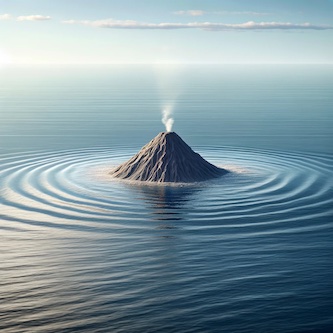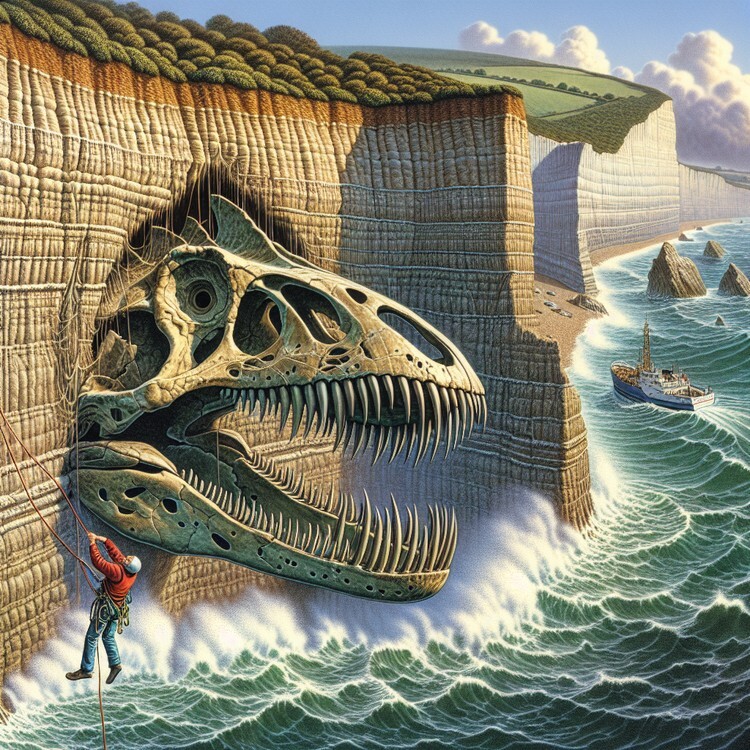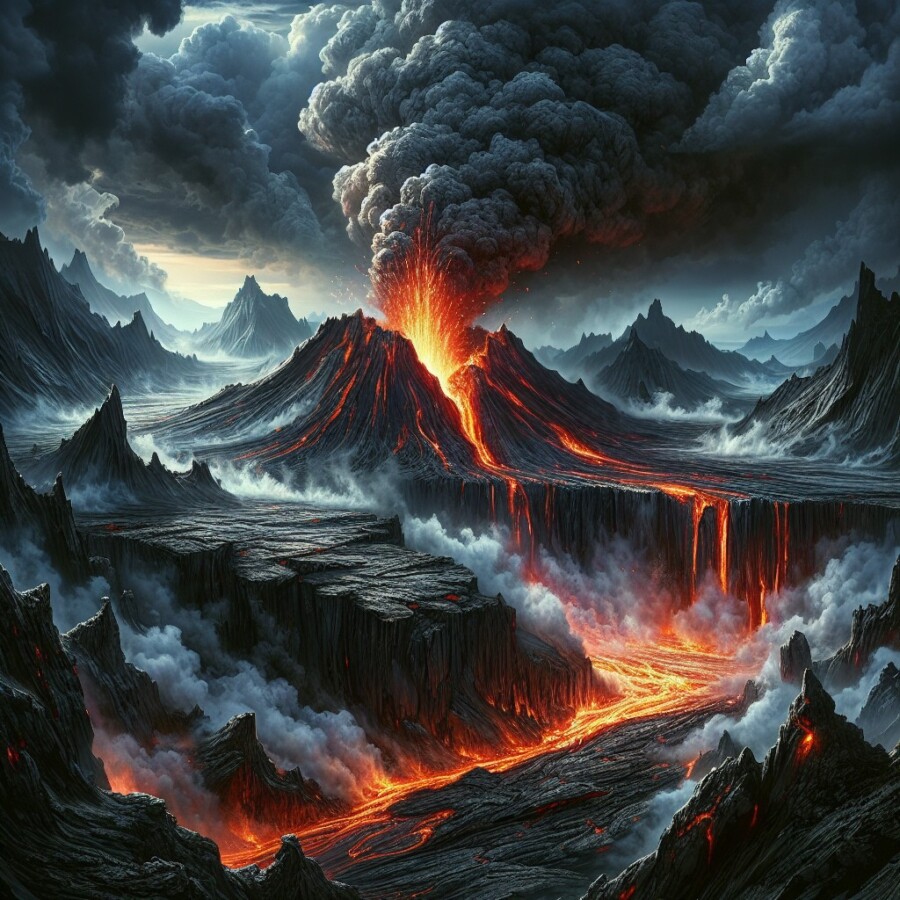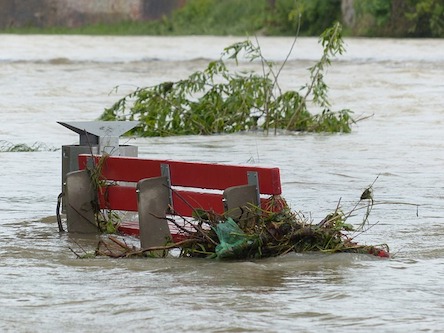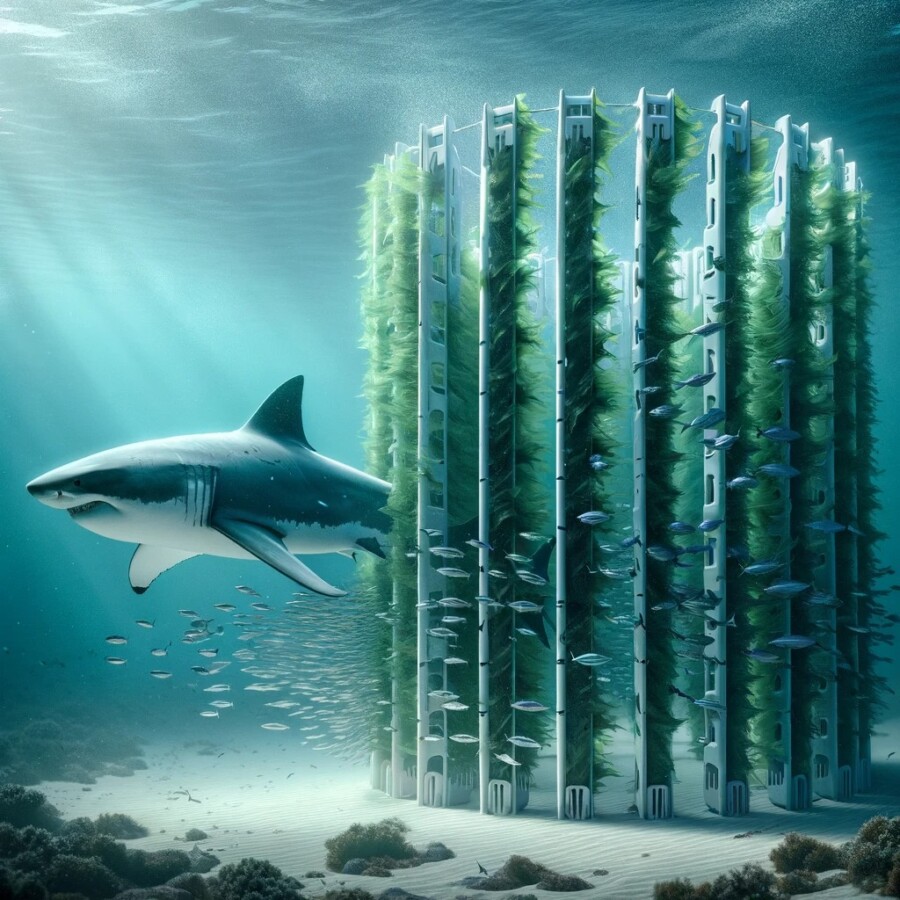Drone footage from Japan has captured a rare moment, showing a volcanic eruption giving birth to a new island. The unnamed undersea volcano began erupting on 21 October, and by early November, the island measured approximately 100 meters in diameter and was as high as 20 meters above the sea. However, the new island, located half a mile off the southern coast of Iwo Jima, has already shrunk due to its “crumbly” formation, making it vulnerable to erosion.
Yuji Usui, an analyst from Japan Meteorological Agency’s volcanic division, provided these details. The island’s formation and subsequent erosion have been closely monitored. The footage shows plumes of smoke and the island’s changing shape as waves hit its fragile structure.
This event is a significant natural occurrence, as it is not often that a new island emerges from a volcanic eruption. The emergence and subsequent changes in the island’s size and shape provide scientists with valuable insights into the geological processes at work.
The new island’s formation has sparked interest and curiosity among researchers and the public alike. It serves as a reminder of the dynamic and ever-changing nature of our planet, offering a unique opportunity for scientific study and observation.
As the island continues to evolve, scientists will closely monitor its development, providing valuable data and contributing to our understanding of volcanic activity and the formation of new land masses.
Original news source: Japan volcano: Plumes of smoke as new island emerges after eruption (BBC)
Listen
Slow
Normal
Fast
Group or Classroom Activities
Warm-up Activities:
– News Summary
Instructions: Students will work in pairs to summarize the article in their own words, aiming to condense the information into four sentences. Each pair will then share their summary with the class, and the class will discuss the varying perspectives and what essential details were included in each summary.
– Sketch It
Instructions: Divide the class into small groups. Each group will be given a segment of the article and tasked with creating a sketch that represents the main points of their assigned section. Once completed, they will present their sketch to the class, explaining how it relates to the content of the article.
– Opinion Spectrum
Instructions: Pose a statement related to the article, such as “The formation and erosion of new islands like the one in Japan are significant events that deserve more media attention.” Have students line up according to how strongly they agree or disagree with the statement, with one end of the room representing ‘strongly agree’ and the other ‘strongly disagree’. Students will then discuss their position with their neighbors on the spectrum and share their reasons with the class.
– Future Predictions
Instructions: Ask students to write a short paragraph predicting the future of the new island and its impact on scientific research, using information from the article to support their predictions. They should consider both short-term and long-term effects. After writing, students will share their predictions with a partner and discuss the likelihood and implications of each other’s scenarios.
– Vocabulary Pictionary
Instructions: Identify key vocabulary from the article (e.g., eruption, geological, erosion, fragile, etc.). Students will play Pictionary in teams where they draw the word for their team to guess without speaking or writing letters or numbers. This will help reinforce new vocabulary and ensure understanding of the article’s key concepts.
Comprehension Questions:
1. What natural event was captured by drone footage in Japan?
2. When did the undersea volcano begin erupting to form the new island?
3. What were the initial dimensions of the new island, in terms of diameter and height?
4. Where is the new island located in relation to Iwo Jima?
5. What has caused the new island to shrink after its formation?
6. Who is Yuji Usui and what role does he play in this scenario?
7. Why is the emergence of the new island considered a significant natural occurrence?
8. How will scientists use the data from the new island’s development?
Go to answers ⇩
Listen and Fill in the Gaps:
Drone footage from Japan has captured a rare moment, (1)______ a (2)______ eruption (3)______ birth to a new island. The unnamed undersea volcano began erupting on 21 October, and by early November, the island (4)______ approximately 100 meters in diameter and was as high as 20 meters above the sea. However, the new island, located half a mile off the southern coast of Iwo Jima, has already shrunk due to its “crumbly” formation, making it vulnerable to (5)______.
Yuji Usui, an analyst from Japan (6)______ Agency’s volcanic division, provided these details. The island’s formation and subsequent erosion have been closely (7)______. The footage shows plumes of smoke and the island’s (8)______ shape as waves hit its fragile structure.
This event is a significant natural occurrence, as it is not often that a new island (9)______ from a volcanic (10)______. The emergence and subsequent changes in the island’s size and shape provide scientists with valuable insights into the geological processes at work.
The new island’s formation has sparked (11)______ and (12)______ among researchers and the public alike. It serves as a reminder of the dynamic and ever-changing (13)______ of our planet, offering a unique opportunity for (14)______ study and observation.
As the island continues to evolve, scientists will closely monitor its (15)______, providing valuable data and contributing to our understanding of volcanic (16)______ and the formation of new land masses.
Go to answers ⇩
Discussion Questions:
Students can ask a partner these questions, or discuss them as a group.
1. What is your opinion on the significance of witnessing the birth of a new island through a volcanic eruption?
2. How would you feel if a new island suddenly appeared near your country’s coastline?
3. Do you think the emergence of new landmasses like this island can have a significant impact on local ecosystems? Why or why not?
4. Have you ever experienced a natural event that changed the geography of a place? What was that like?
5. What is the most fascinating geological phenomenon you have learned about, and why does it interest you?
6. How do you think the formation of a new island could affect maritime boundaries and international relations?
7. Do you like the idea of visiting a newly formed volcanic island? Why or why not?
8. Do you think human intervention should be allowed to protect fragile formations like the new island from erosion? Why or why not?
9. What is your perspective on the importance of monitoring and studying volcanic activity?
10. How would you feel about the prospect of new islands potentially providing new habitats for wildlife?
11. Do you think the formation of new islands is something that should be celebrated or approached with caution? Why?
12. Have you ever seen drone footage of a natural event? What impact did it have on your understanding of the event?
13. What is the most dynamic natural change you have witnessed in your lifetime, and how did it affect you or your community?
14. Do you think the creation of a new island like this should be covered more in the media? Why or why not?
15. How do you imagine the world map might change over the next century due to natural events like volcanic eruptions?
Individual Activities
Vocabulary Meanings:
Match each word to its meaning.
Words:
1. eruption
2. island
3. volcanic
4. diameter
5. vulnerable
6. analyst
7. plumes
8. emergence
Meanings:
(a) Related to or produced by a volcano
(b) Susceptible to physical or emotional attack or harm
(c) A visible column of smoke or dust
(d) A straight line passing from side to side through the center of a circle or sphere
(e) A piece of land surrounded by water
(f) The sudden bursting out of something
(g) A person who examines and interprets data
(h) The process of coming into being or becoming visible
Go to answers ⇩
Multiple Choice Questions:
1. When did the volcanic eruption that created the new island in Japan begin?
(a) 1 November
(b) 21 October
(c) 15 October
(d) 10 November
2. How big was the new island when it was first measured?
(a) 100 meters in diameter
(b) 50 meters in diameter
(c) 200 meters in diameter
(d) 150 meters in diameter
3. Where is the new island located?
(a) Half a mile off the northern coast of Iwo Jima
(b) In the middle of Iwo Jima
(c) On the eastern coast of Iwo Jima
(d) Half a mile off the southern coast of Iwo Jima
4. What is the reason for the new island’s vulnerability to erosion?
(a) Its solid rock formation
(b) Its smooth surface
(c) Its “crumbly” formation
(d) Its large size
5. Who provided the details about the new island’s formation and erosion?
(a) Sato Takahashi
(b) Hiroshi Yamamoto
(c) Akira Nakamura
(d) Yuji Usui
6. What does the footage of the new island show?
(a) Birds flying around the island
(b) Plumes of smoke and the island’s changing shape
(c) Underwater marine life near the island
(d) People exploring the island
7. Why is the emergence of a new island from a volcanic eruption significant?
(a) It is not often that a new island emerges from a volcanic eruption
(b) It happens every year
(c) It is a common occurrence
(d) It has no scientific significance
8. What does the new island’s formation provide scientists with?
(a) Information about marine life
(b) Data about weather patterns
(c) Valuable insights into the geological processes at work
(d) Nothing of scientific value
Go to answers ⇩
True or False Questions:
1. The named undersea volcano began erupting on 21 October.
2. The emergence of a new island from a volcanic eruption is an insignificant natural occurrence.
3. By early November, the new island measured approximately 100 meters in diameter and was only 10 meters above the sea.
4. The footage shows plumes of smoke and the island’s changing shape as waves hit its fragile structure.
5. Yuji Usui, an analyst from Japan Meteorological Agency’s volcanic division, provided details about the new island’s formation and subsequent erosion.
6. The new island has already shrunk due to its “crumbly” formation, making it vulnerable to erosion.
7. The new island’s formation has sparked interest and curiosity among researchers and the public, offering a unique opportunity for scientific study and observation.
8. Drone footage from France captured a volcanic eruption giving birth to a new island.
Go to answers ⇩
Write a Summary:
Write a summary of this news article in two sentences.
Writing Questions:
Answer the following questions. Write as much as you can for each answer.
1. What was the size and height of the new island formed by the volcanic eruption off the coast of Iwo Jima?
2. What challenges is the newly formed island facing that affect its size and stability?
3. Who is Yuji Usui, and what role does he play in the context of the volcanic eruption and the new island?
4. Why is the emergence of a new island from a volcanic eruption considered a significant natural occurrence?
5. In what ways will scientists benefit from monitoring the development of the new island?
Answers
Comprehension Question Answers:
1. What natural event was captured by drone footage in Japan?
Drone footage in Japan captured a rare moment of a volcanic eruption that led to the formation of a new island.
2. When did the undersea volcano begin erupting to form the new island?
The undersea volcano began erupting on 21 October.
3. What were the initial dimensions of the new island, in terms of diameter and height?
The new island initially measured approximately 100 meters in diameter and was as high as 20 meters above the sea.
4. Where is the new island located in relation to Iwo Jima?
The new island is located half a mile off the southern coast of Iwo Jima.
5. What has caused the new island to shrink after its formation?
The new island has shrunk due to its “crumbly” formation, making it vulnerable to erosion.
6. Who is Yuji Usui and what role does he play in this scenario?
Yuji Usui is an analyst from Japan Meteorological Agency’s volcanic division, and he provided details about the island’s formation and subsequent erosion.
7. Why is the emergence of the new island considered a significant natural occurrence?
The emergence of the new island is considered a significant natural occurrence because it is a rare event where a new landmass emerges from a volcanic eruption, providing insights into geological processes.
8. How will scientists use the data from the new island’s development?
Scientists will closely monitor the island’s development, using the data to contribute to our understanding of volcanic activity and the formation of new land masses.
Go back to questions ⇧
Listen and Fill in the Gaps Answers:
(1) showing
(2) volcanic
(3) giving
(4) measured
(5) erosion
(6) Meteorological
(7) monitored
(8) changing
(9) emerges
(10) eruption
(11) interest
(12) curiosity
(13) nature
(14) scientific
(15) development
(16) activity
Go back to questions ⇧
Vocabulary Meanings Answers:
1. eruption
Answer: (f) The sudden bursting out of something
2. island
Answer: (e) A piece of land surrounded by water
3. volcanic
Answer: (a) Related to or produced by a volcano
4. diameter
Answer: (d) A straight line passing from side to side through the center of a circle or sphere
5. vulnerable
Answer: (b) Susceptible to physical or emotional attack or harm
6. analyst
Answer: (g) A person who examines and interprets data
7. plumes
Answer: (c) A visible column of smoke or dust
8. emergence
Answer: (h) The process of coming into being or becoming visible
Go back to questions ⇧
Multiple Choice Answers:
1. When did the volcanic eruption that created the new island in Japan begin?
Answer: (b) 21 October
2. How big was the new island when it was first measured?
Answer: (a) 100 meters in diameter
3. Where is the new island located?
Answer: (d) Half a mile off the southern coast of Iwo Jima
4. What is the reason for the new island’s vulnerability to erosion?
Answer: (c) Its “crumbly” formation
5. Who provided the details about the new island’s formation and erosion?
Answer: (d) Yuji Usui
6. What does the footage of the new island show?
Answer: (b) Plumes of smoke and the island’s changing shape
7. Why is the emergence of a new island from a volcanic eruption significant?
Answer: (a) It is not often that a new island emerges from a volcanic eruption
8. What does the new island’s formation provide scientists with?
Answer: (c) Valuable insights into the geological processes at work
Go back to questions ⇧
True or False Answers:
1. The named undersea volcano began erupting on 21 October. (Answer: False)
2. The emergence of a new island from a volcanic eruption is an insignificant natural occurrence. (Answer: False)
3. By early November, the new island measured approximately 100 meters in diameter and was only 10 meters above the sea. (Answer: False)
4. The footage shows plumes of smoke and the island’s changing shape as waves hit its fragile structure. (Answer: True)
5. Yuji Usui, an analyst from Japan Meteorological Agency’s volcanic division, provided details about the new island’s formation and subsequent erosion. (Answer: True)
6. The new island has already shrunk due to its “crumbly” formation, making it vulnerable to erosion. (Answer: True)
7. The new island’s formation has sparked interest and curiosity among researchers and the public, offering a unique opportunity for scientific study and observation. (Answer: True)
8. Drone footage from France captured a volcanic eruption giving birth to a new island. (Answer: False)
Go back to questions ⇧




